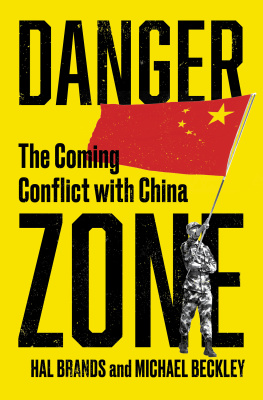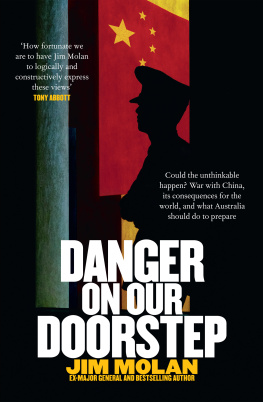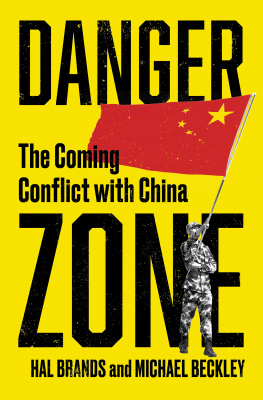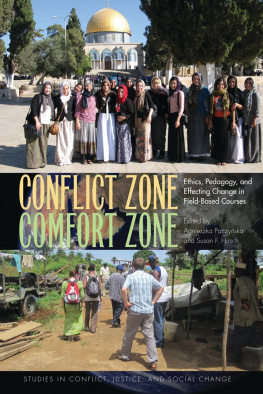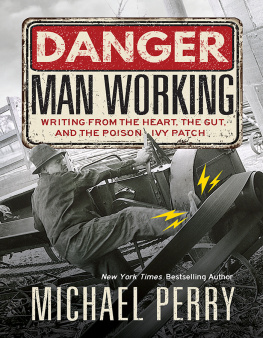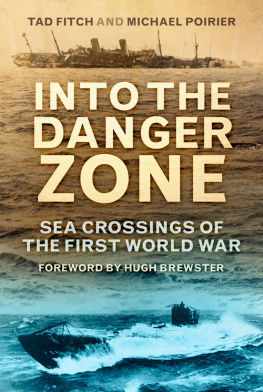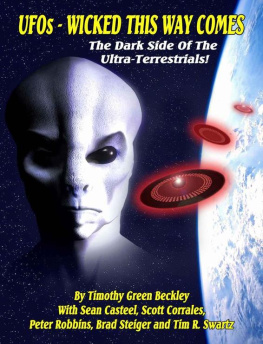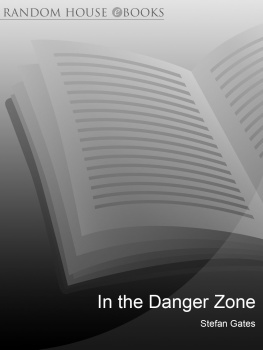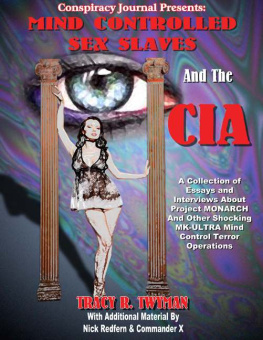Michael Beckley - Danger Zone: The Coming Conflict With China
Here you can read online Michael Beckley - Danger Zone: The Coming Conflict With China full text of the book (entire story) in english for free. Download pdf and epub, get meaning, cover and reviews about this ebook. year: 2022, publisher: Norton, genre: Politics. Description of the work, (preface) as well as reviews are available. Best literature library LitArk.com created for fans of good reading and offers a wide selection of genres:
Romance novel
Science fiction
Adventure
Detective
Science
History
Home and family
Prose
Art
Politics
Computer
Non-fiction
Religion
Business
Children
Humor
Choose a favorite category and find really read worthwhile books. Enjoy immersion in the world of imagination, feel the emotions of the characters or learn something new for yourself, make an fascinating discovery.
- Book:Danger Zone: The Coming Conflict With China
- Author:
- Publisher:Norton
- Genre:
- Year:2022
- Rating:5 / 5
- Favourites:Add to favourites
- Your mark:
- 100
- 1
- 2
- 3
- 4
- 5
Danger Zone: The Coming Conflict With China: summary, description and annotation
We offer to read an annotation, description, summary or preface (depends on what the author of the book "Danger Zone: The Coming Conflict With China" wrote himself). If you haven't found the necessary information about the book — write in the comments, we will try to find it.
Danger Zone: The Coming Conflict With China — read online for free the complete book (whole text) full work
Below is the text of the book, divided by pages. System saving the place of the last page read, allows you to conveniently read the book "Danger Zone: The Coming Conflict With China" online for free, without having to search again every time where you left off. Put a bookmark, and you can go to the page where you finished reading at any time.
Font size:
Interval:
Bookmark:

DANGER
ZONE
The Coming Conflict with China

HAL BRANDS
and
MICHAEL BECKLEY

W.W. NORTON & COMPANY
Independent Publishers Since 1923
For our families
I t is January 18, 2025, and a war is about to start. The U.S. presidential inauguration is only two days away, but the election results remain contested. Both the Democratic and Republican candidates are claiming victory and preparing to take the oath of office while millions of their supporters clash in the streets. It is Americas second straight disputed election, this time accompanied by a crisis on the other side of the world.
China is conducting massive naval exercises in the Taiwan Strait. The Peoples Liberation Army (PLA) has also positioned a menacing medley of forcesairborne and amphibious assault troops, strike aircraft, thousands of ballistic missilesopposite Taiwan. Such shows of strength have become a regular occurrence over the past half-decade, as China flexes its muscles vis--vis an island it considers a renegade province. Xi Jinping, now in his thirteenth year atop the Chinese Communist Party (CCP), has repeatedly warned Taiwan that it must submit to Beijings authorityand told the United States to mind its own business. Anyone who tries to slow Chinas progress, he likes to say, will have their heads bashed bloody against a Great Wall of steel.
High above the western Pacific, U.S. spy satellites watch the military preparations. Americas world-class signals intelligence capabilities detect Chinas mobilization. But U.S. analysts assume that this is just another case of Xis habitual saber-rattlinga feint designed to unnerve Taiwans population and overstretch its military.
They are wrong.
At 10:01 pm EST (the next morning in Beijing and Taipei), Chinese forces unleash hell. Short- and medium-range missiles pound airfields, government buildings, and military installations all over Taiwan, as well as Americas key regional air bases on Okinawa and Guam. The USS Ronald Reagan, the Pentagons sole aircraft carrier in the region, suffers a direct hit from an anti-ship ballistic missile. Chinese special forces, secretly infiltrated into Taiwan beforehand, sabotage infrastructure, try to decapitate the government by killing its top leaders, and sow panic among the population. Chinas cyber warriors take down Taiwans power grid, plunging the island into blackness, and spoof U.S. satellites. Meanwhile, Beijing unleashes a global disinformation campaign blaming the crisis on Taiwan and roiling a chaotic political scene in the United States.
All this is preparation for the main event. The Chinese fleet conducting exercises now pivots to launch an amphibious landing on Taiwans most accessible western beach. Chinese commercial car ferries plying the strait suddenly disgorge small, amphibious landing craft. On the mainland, airborne forces prepare to seize Taiwanese airfields and ports, paving the way for the main assault of hundreds of thousands of troops. The long-feared Chinese invasion of Taiwan has begun, as has a multi-vector attack on Americas ability to respond.
In Taipei, the situation soon borders on irretrievable. In Washington, the news is also grim. Aides inform an ailing President Biden that he has little time and no good options.
America cannot abandon Taiwan without betraying 25 million democratic citizens and shredding the credibility of its alliances with the Philippines and Japan. A Chinese-controlled Taiwan could be a stepping-stone to expansion throughout East Asia and beyond. But America cannot stop the assault without risking a war that could be bigger and costlier than anything since World War II.
In the White House Situation Room, the secretary of defense tells Biden that the bloodied U.S. forces in the western Pacific are unable to repel the Chinese invasion. Additional U.S. aircraft, warships, and submarines scattered everywhere from Hawaii to the Persian Gulf can try to fight their way toward the Taiwan Strait through a gauntlet of Chinese missiles, mines, and air defenses. But this will take days if not weeks and result in heavy losses with no guarantee of success. Alternatively, the U.S. Navy can blockade Chinas energy imports and food supplies, but that strangulation strategy will take monthstime that Taiwan doesnt have.
That leaves one sure way to stop the invasion: Strike Chinese forces with low-yield nuclear weapons as they load in mainland ports and airfields. America is still the stronger power, Bidens advisers tell him; it can win a big war if it throws everything it has into the fight. But such a conflict might end up destroying Taiwan in order to save itand prove disastrous for America and China alike.

How did the United States and China come to the brink of World War III?
At the time, most analysts assumed that Xis decision to attack was China was simultaneously racing for supremacy in key technologies such as artificial intelligence and quantum computing; through its Digital Silk Road initiative, it was building a twenty-first century sphere of influence. Xi Jinping had consolidated power and made himself the worlds mightiest dictator since Joseph Stalin, while Americas politics continued to be a tribal, polarized messand Americas attention was diverted by other crises and conflicts around the globe. Never before had the Peoples Republic of China (PRC) possessed such military strength and economic influence vis--vis its rivals. By outward appearances, Xis Chinese Dreamhis ambition to make China dominant in Asia and around the globewas on the verge of becoming a reality.
But Xi was tormented by the nightmare of Chinese decline. For years, the pressures on the CCP regime had been mounting. Once-torrid economic growth had slowed to a crawl. The legacy of the One-Child policy was demographic disasteran impending loss of nearly 200 million working-age individuals in China by mid-century. The regime had become more repressive as it grew ever more petrified of dissent. And in response to Chinese belligerence during the COVID-19 pandemic and for years thereafter, the democratic world had gradually been closing ranks to check Beijings rise. Taiwan was finally starting to shore up its inadequate military defenses, as its population rejected any suggestion of reunification with China. The United Statesa country with a unique talent for slaying autocratic rivalswas waging a tech and tariff war against Chinas economy while retooling its military to take on the PLA.
On the eve of war, the world still saw China as a rising power. Yet Xi saw a future of stagnation, strategic encirclement, and decay. So he gambled, with catastrophic consequences for the region and the world, because he knew his moment of opportunity wouldnt last long.

The rise of China may be the most read-about news story of the twenty-first century.
China is certainly acting like it wants to run the show. The CCP is laying plans to create a Sino-centric Asia and reclaim what it sees as Chinas rightful place atop the global hierarchy. Beijing is using an impressive array of military, economic, diplomatic, technological, and ideological tools to protect the power and project the influence of a brutal authoritarian regime. The United States, for its part, is trying to defend a liberal international order it has anchored for generations and prevent Beijing from making the twenty-first century an age of autocratic ascendancy. America and China are thus locked in a fierce global struggle. It has become conventional wisdom in Washingtona rare point of agreement in a bitterly divided capitalthat the two countries are running a superpower marathon that may last a century.
Next pageFont size:
Interval:
Bookmark:
Similar books «Danger Zone: The Coming Conflict With China»
Look at similar books to Danger Zone: The Coming Conflict With China. We have selected literature similar in name and meaning in the hope of providing readers with more options to find new, interesting, not yet read works.
Discussion, reviews of the book Danger Zone: The Coming Conflict With China and just readers' own opinions. Leave your comments, write what you think about the work, its meaning or the main characters. Specify what exactly you liked and what you didn't like, and why you think so.

